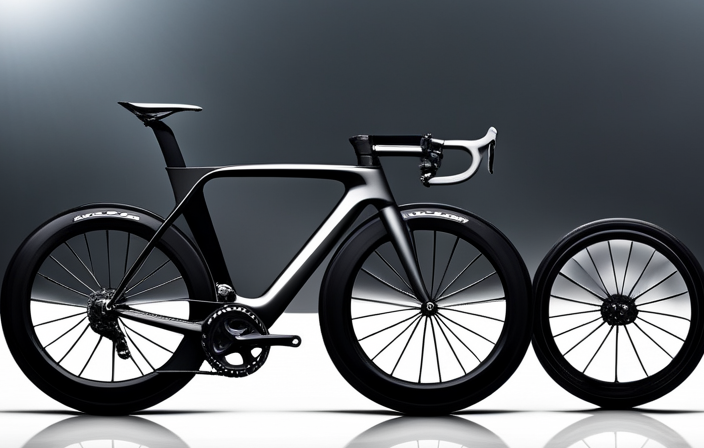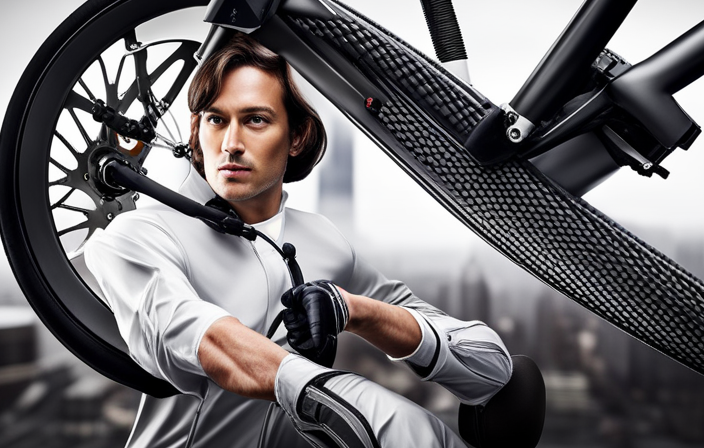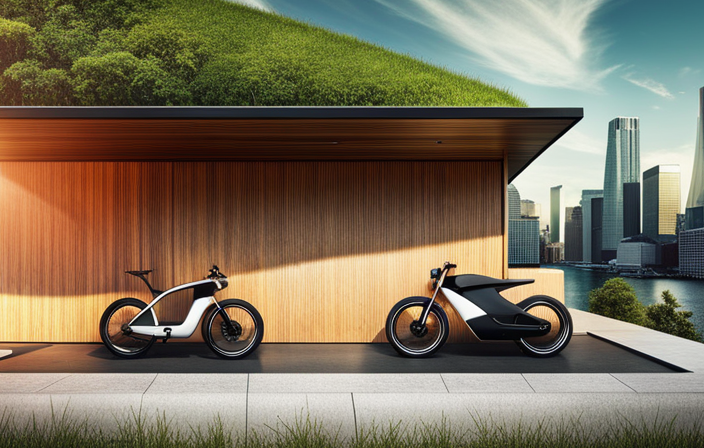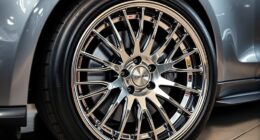Picture the thrill of zooming down the street at lightning speed, feeling the wind whip against your face as you test the boundaries of what a bike can achieve.
In this article, we delve into the world of high-performance bicycles and explore what makes them the fastest of their kind.
From the importance of aerodynamics and lightweight materials to cutting-edge gear systems and innovative advancements, we uncover the secrets behind these speed machines.
So buckle up and get ready to discover the ultimate thrill of riding the fastest bicycle on the planet.
Key Takeaways
- Suspension systems, braking systems, and bicycle design all play a significant role in determining the speed of a bicycle.
- Professional cycling and advancements in technology often set the standards and push the limits of speed in the cycling world.
- Technological advancements, such as electric bikes and aerodynamic designs, are shaping the future of speed in cycling.
- Training and technique are crucial factors in maximizing speed, with a focus on optimizing pedaling technique, mental preparation, and cardiovascular endurance.
The Need for Speed: Exploring the World of High-Performance Bicycles
If you want to explore the world of high-performance bicycles, you’ll need to understand the need for speed.
In order to achieve top speeds on a bicycle, various factors come into play, including aerodynamic advancements and speed training techniques.
Advancements in aerodynamics have revolutionized the design of high-performance bicycles, allowing riders to cut through the air with minimal resistance. These advancements include streamlined frames, aerodynamic wheelsets, and even integrated handlebars that reduce drag.
Additionally, speed training techniques play a crucial role in maximizing a cyclist’s potential. This includes interval training, hill repeats, and focusing on power output. By incorporating these techniques into their training regimen, cyclists can improve their speed and endurance.
Understanding the role of aerodynamics in speed is essential for any cyclist looking to push their limits and reach new levels of performance.
The Role of Aerodynamics in Speed
To maximize your speed, you’ll want to focus on the role of aerodynamics. Aerodynamic design plays a crucial role in reducing drag and maximizing efficiency. The use of wind tunnel testing allows engineers to fine-tune the shape and design of a bicycle to minimize air resistance.
When it comes to aerodynamics, there are a few key factors to consider:
-
Streamlined Frame: A bicycle with a streamlined frame, featuring smooth lines and minimal surface area, can greatly reduce drag.
-
Integrated Components: Integrating components such as brakes and cables into the frame can further reduce turbulence and improve aerodynamics.
-
Deep-section Wheels: Deep-section wheels are designed to slice through the air, reducing drag and increasing speed.
By focusing on these aerodynamic factors, cyclists can achieve faster speeds and better performance.
Transitioning into the subsequent section about lightweight materials: the key to maximum speed, we can further optimize the bicycle for even greater performance.
Lightweight Materials: The Key to Maximum Speed
Using lightweight materials is essential for achieving maximum speed on a bicycle. Lightweight materials not only reduce the overall weight of the bike, but also play a crucial role in enhancing its durability and performance.
By using materials such as carbon fiber, titanium, and aluminum alloys, manufacturers are able to create frames and components that are both lightweight and strong. This allows cyclists to exert less effort when pedaling, resulting in increased speed.
Additionally, weight distribution is a key factor in speed optimization. By strategically placing lightweight materials in specific areas of the bike, such as the frame and wheels, the weight can be evenly distributed, allowing for better handling and improved acceleration.
With the right combination of lightweight materials and optimal weight distribution, cyclists can achieve unparalleled speed and performance.
Speaking of speed optimization, the subsequent section will delve into the importance of frame geometry in achieving maximum velocity.
The Importance of Frame Geometry in Speed Optimization
The geometry of a bicycle frame plays a crucial role in optimizing speed and performance. Frame materials, such as carbon fiber or titanium, are chosen for their lightweight properties, allowing for efficient power transfer and maneuverability.
However, it is not just about the material used; the shape and design of the frame also greatly impact speed. By utilizing wind tunnel testing, engineers can determine the most aerodynamic frame shape, reducing drag and maximizing efficiency.
The frame geometry affects factors such as stability, handling, and comfort, all of which contribute to the overall speed of the bicycle.
As we delve into the realm of cutting-edge gear systems for enhanced speed, it is important to remember that the frame geometry acts as the foundation for all other speed optimization techniques.
Cutting-Edge Gear Systems for Enhanced Speed
Upgrade your ride with cutting-edge gear systems that will take your speed to the next level.
-
Experience the power of electronic shifting, allowing for precise and lightning-fast gear changes at the touch of a button.
-
Take advantage of innovative gear technology, such as wide-range cassettes, which provide a greater range of gears to tackle any terrain.
-
Benefit from aerodynamic advancements, such as hidden cables and integrated derailleur hangers, reducing drag and increasing efficiency.
-
Explore the world of lightweight carbon fiber components, ensuring optimal power transfer and minimal weight for maximum speed.
These advancements in gear systems not only enhance your speed but also improve your overall riding experience.
As we dive into the role of tires and wheels in speed performance, it becomes clear that every component of a bicycle plays a crucial role in achieving top speeds.
The Role of Tires and Wheels in Speed Performance
Get ready to experience a significant boost in speed and performance with the role of tires and wheels in enhancing your riding experience.
When it comes to speed, tire pressure and wheel size play a crucial role. The right tire pressure can make all the difference in reducing rolling resistance and increasing efficiency. By finding the optimal pressure for your tires, you can ensure maximum speed and control on the road.
Additionally, wheel size also affects speed performance. Smaller wheels offer quicker acceleration and improved maneuverability, while larger wheels provide better stability and higher top speeds. Finding the right balance between tire pressure and wheel size is key to achieving the fastest bicycle.
So, now that we understand the importance of tires and wheels, let’s dive into the next section about the power of pedaling: high-performance cranksets and pedals.
The Power of Pedaling: High-Performance Cranksets and Pedals
When it comes to speed, every component of a bicycle plays a crucial role. We’ve already explored the importance of tires and wheels in maximizing performance. Now, let’s discuss another key element: high-performance cranksets and pedals.
These components are responsible for converting the power generated by the rider’s legs into forward motion. High-performance cranksets are designed to be lightweight and stiff, allowing for efficient power transfer with each pedal stroke. Paired with pedals that provide optimal grip and support, these cranksets can significantly improve overall pedal efficiency.
To enhance speed, it’s crucial to maximize power output while minimizing energy loss. High-performance cranksets and pedals help achieve this balance, allowing riders to generate more speed with less effort.
Now, let’s explore another aspect that impacts a bicycle’s speed: the effect of suspension systems.
The Impact of Suspension Systems on Speed
Suspension systems can significantly affect the speed and performance of a bike. When it comes to speed optimization, suspension plays a crucial role in providing a smooth and controlled ride. By absorbing the impacts of rough terrain, suspension systems allow the wheels to maintain better contact with the ground, minimizing energy loss and maximizing speed.
The impact of suspension systems on speed can be seen in off-road biking, where riders face uneven surfaces and obstacles. A well-designed suspension system helps riders maintain better control, allowing them to navigate through challenging terrain at higher speeds. However, it is important to find the right balance, as suspension systems that are too soft can lead to energy loss and reduced efficiency.
Transitioning into the next section, the role of braking systems is essential for both fast and safe cycling.
The Role of Braking Systems in Fast and Safe Cycling
To ensure a fast and safe cycling experience, you’ll need to rely on the proper functioning of your braking system. Braking efficiency is crucial for controlling your speed and avoiding accidents. Here are some key safety measures to consider:
-
Regular maintenance: Keep your braking system in top condition by checking the brake pads, cables, and levers regularly. Replace worn-out parts promptly to maintain optimal braking performance.
-
Proper adjustment: Ensure that your brakes are properly aligned and adjusted to provide maximum stopping power. This will improve your ability to slow down or come to a quick stop when needed.
-
Technique: Learn and practice proper braking techniques, such as using both front and rear brakes simultaneously for better control and evenly distributing the braking force.
By following these safety measures, you can enhance your braking efficiency and ride with confidence.
Transitioning to the subsequent section about the influence of professional cycling in pushing speed limits, we can explore how these advancements impact bicycle design and performance.
The Influence of Professional Cycling in Pushing Speed Limits
Professional cycling has greatly influenced the push for higher speed limits in the sport. As athletes continue to break records and push boundaries, the focus on speed has become a central aspect of professional cycling.
However, with the pursuit of higher speeds comes an increased risk of injury. The psychology of speed plays a significant role in professional cycling, as riders need to balance the exhilaration of speed with the potential dangers it presents.
This psychological aspect, coupled with advancements in technology and training methods, has led to the development of faster bicycles and the constant push for even greater speeds.
As we delve into the next section about record-breaking speed and the unveiling of the fastest bicycles in history, we will see the culmination of these influences and breakthroughs in cycling performance.
Record-Breaking Speed: Unveiling the Fastest Bicycles in History
Breaking speed records in professional cycling has led to the unveiling of bikes that have achieved unprecedented levels of velocity. These record-breaking achievements are a testament to the advancements in technology that have revolutionized the design and construction of bicycles.
Over the years, manufacturers and engineers have constantly pushed the boundaries of what is possible, resulting in bikes that are lighter, more aerodynamic, and technologically advanced. From the introduction of carbon fiber frames to the development of streamlined shapes and high-performance components, every aspect of the bicycle has been optimized for speed.
These innovations have not only allowed professional cyclists to reach incredible speeds, but they have also inspired recreational riders to seek faster and more efficient bikes.
As we delve into the future of speed: innovations and technological advancements, it becomes clear that the quest for faster bicycles is far from over.
The Future of Speed: Innovations and Technological Advancements
After taking a deep dive into the record-breaking speed achievements of the past, it’s time to shift our focus towards the future of speed in cycling.
The advancements in technology and innovative propulsion systems have paved the way for an exciting future in the world of cycling. From electric bikes to aerodynamic designs, the possibilities seem endless. Imagine a bicycle that can harness the power of wind or solar energy to propel you forward at incredible speeds. The future of cycling technology holds the promise of not only pushing the boundaries of speed but also making cycling more accessible and sustainable.
But speed is not solely dependent on technology. In the next section, we will explore the role of training and technique in maximizing speed, because without proper training, even the most advanced bicycle won’t take you far.
The Role of Training and Technique in Maximizing Speed
To maximize your speed, it’s crucial to focus on training and technique. When it comes to cycling, maximizing efficiency is key.
One important aspect is optimizing your pedaling technique. Make sure to pedal in a circular motion, applying force evenly throughout the entire rotation.
Another factor to consider is your body position. Maintaining an aerodynamic posture reduces wind resistance, allowing you to cut through the air more efficiently.
Mental preparation is also essential. Visualize yourself riding at high speeds, focus on your breathing, and stay mentally engaged throughout your training sessions.
Lastly, incorporate interval training and hill sprints into your routine to improve your cardiovascular endurance and leg strength. Remember, training and technique are the foundation for achieving top speeds on a bicycle.
Now, let’s discuss safety considerations for high-speed cycling.
Safety Considerations for High-Speed Cycling
When cycling at high speeds, it’s important to prioritize safety by wearing a helmet and protective gear. Safety equipment such as knee and elbow pads, as well as gloves, can provide an extra layer of protection in case of a fall or accident.
Additionally, training techniques are crucial in ensuring a safe and enjoyable high-speed cycling experience. Proper training can improve balance, control, and reaction times, which are essential for quick maneuvers and avoiding obstacles on the road.
It’s also important to be aware of and follow traffic laws and signals, as well as stay vigilant of other road users. By prioritizing safety through the use of proper safety equipment and training techniques, cyclists can minimize the risks associated with high-speed cycling and fully enjoy their ride.
Now, let’s move on to choosing the right fast bicycle for your needs.
Choosing the Right Fast Bicycle for Your Needs
One important factor in selecting the right fast bike for your needs is considering the terrain you will be riding on.
Choosing the right bicycle for speed requires careful consideration of several factors. Firstly, you need to determine whether you will be riding on smooth pavement, rough trails, or a combination of both.
For smooth pavement, a road bike with thin tires and a lightweight frame would be ideal to minimize resistance and maximize speed.
On the other hand, if you plan on tackling rough trails or off-road terrain, a mountain bike with wider tires and a sturdy frame would be more suitable to handle the bumps and obstacles.
Additionally, the gear ratios of the bike should be taken into account. Bicycles with a wide range of gears allow you to maintain a consistent and efficient pedaling cadence, enabling you to achieve higher speeds.
Lastly, the overall aerodynamics of the bike should be considered. Bicycles with aero frames, streamlined components, and aerodynamic wheels can reduce wind resistance, allowing you to cut through the air more efficiently and achieve faster speeds.
All these factors play a crucial role in selecting the perfect fast bicycle for your specific needs.
Frequently Asked Questions
What are some safety considerations to keep in mind when cycling at high speeds?
When cycling at high speeds, it’s important to prioritize safety. Wearing proper safety gear, such as a helmet and reflective clothing, is essential. Additionally, mastering handling techniques like braking and cornering can help prevent accidents and maintain control.
How do training and technique play a role in maximizing speed on a bicycle?
Training techniques are crucial for maximizing speed on a bicycle. By focusing on proper form, strength training, and interval workouts, cyclists can improve their power and endurance, ultimately optimizing their speed on the bike.
What factors should be considered when choosing a fast bicycle that suits your needs?
When choosing a fast bicycle that suits your needs, it’s important to consider factors such as bike frame materials and aerodynamic design. These elements can greatly impact the speed and efficiency of your ride.
Are there any specific innovations or technological advancements in the future that could further enhance speed in bicycles?
In the future, we can expect exciting advancements in bicycle technology that will enhance speed. Innovations like improved aerodynamic designs will allow for greater efficiency and ultimately faster rides.
How does professional cycling influence the boundaries of speed in bicycles?
Professional cycling’s impact on bicycle speed is significant. The sport pushes the boundaries of aerodynamics in racing, leading to advancements in bike design and technology. These innovations ultimately trickle down to improve the performance of all bicycles.
Conclusion
In conclusion, the world of high-performance bicycles offers a thrilling array of options when it comes to speed. From aerodynamics to lightweight materials, frame geometry to cutting-edge gear systems, every aspect is carefully designed to maximize velocity.
The future holds even more exciting innovations and technological advancements that will push the boundaries of speed even further. However, it is important to remember that speed is not just about the bike, but also about the rider’s training and technique.
So, strap on your helmet, grab your hyper-fast bicycle, and prepare to soar through the streets like a shooting star!









